MOORHENS : Gallinula chloropus
Some know this as the "common gallinule". See notes below for clarification.
Coots and moorhens are related to rails and crakes. In West Dunbartonshire, you may well come across both coots and moorhens. They tend to keep to keep to calmer water such as reservoirs and canals.
Moorhens are slightly smaller than their cousins the coots. They are black with a red and yellow beak and long, green legs. While they can swim or at least paddle quite well, they are often seen walking over partially sunken vegetation looking for food. They may even leave the water and wander across a path or lawn.
This one below (or perhaps a descendant) has frequented the lade within the Lomond Industrial area for several seasons. Rather a dirty habitat, but generally out of the way of marauders. It (or a partner) has been seen in a tree, but they usually stay on the exposed mud and near the water.
Compare with : COOTS
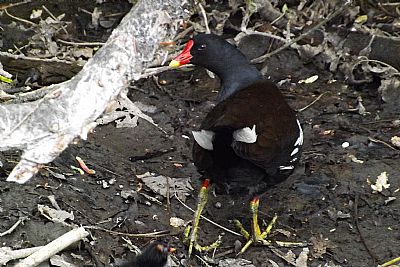
A moorhen mum looks after a small black chick. She got anxious about being photographed, got off the nest and hid it, calling in sharp tweets all the time.
A lade off the Leven near Alexandria, first week of May.
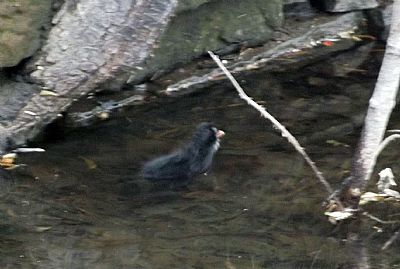
And this is what all the fuss is about. A single chick just over a week old. Hardly visible in the gloom below the lade wall and in amongst the vegetation and rubbish. But it is well able to dart about at the beckoning call of its mother. A second adult moorhen was close by too, presumably the dad.
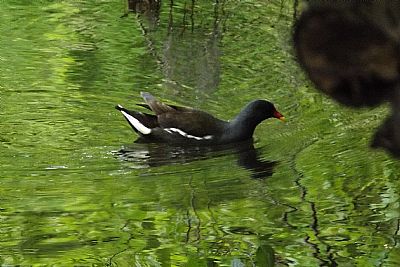
Two weeks later and we find a solitary moorhen on the lade. No sign of a mate nor of a youngster. These may simply be very good at hiding, but it is of concern.
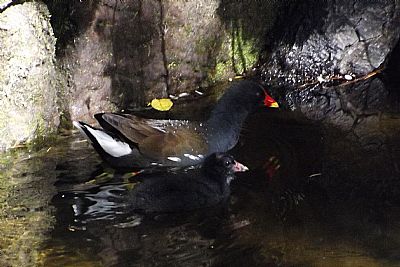
But in the second week in July, there it is. Mother and chick. She instinctively keeps it in the dark gloom of the lade. The low branches, the mud where exposed and the light are all dark. The chick is difficult to see for both predators and inquisitive humans.
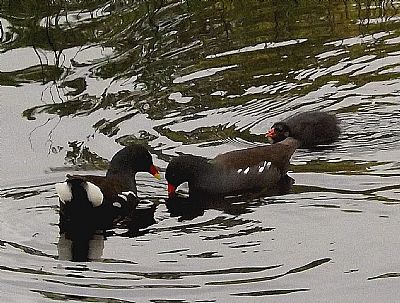
This and the next 3 photos were taken on the skating pond above Helensburgh. (Once used for that). Perhaps the constant number of walkers and the refuges in the water grasses gave this young family, one of three, more confidence to be out and about.
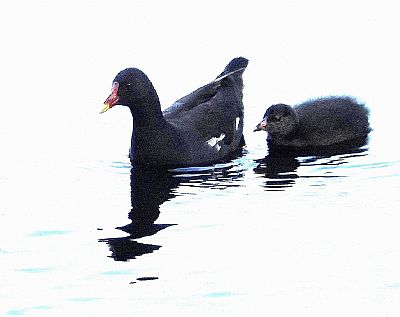
That little black pompom starts to grow and mum tries to keep it under her watchful eye while ......
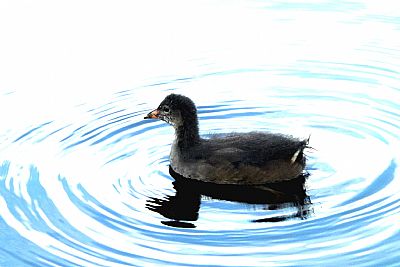
......they go through a somewhat straggly phase...
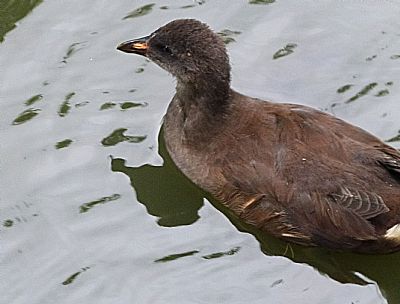
A few weeks old by now. Early June.
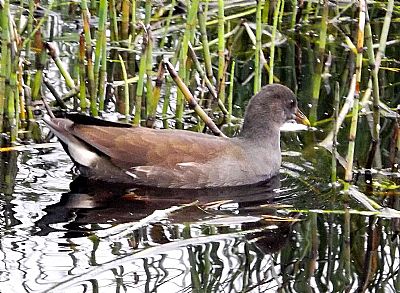
.... before becoming rather elegant grey teenagers
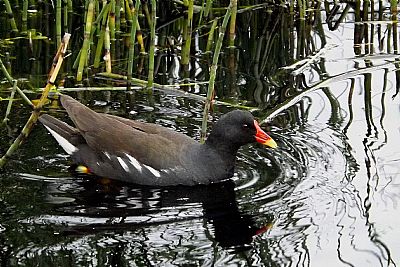
Their adult plumage though is very striking.
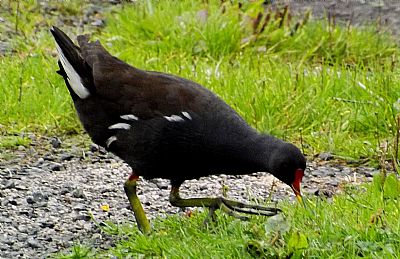
Moorhens can be seen swimming on inalnd waters. Or are they really swimming? Their long toes enable them to walk across floating vegetation and are quite happy out of the water for short distances. In many cases what appears to be swimming is actually walking along the bottom of shallow water.
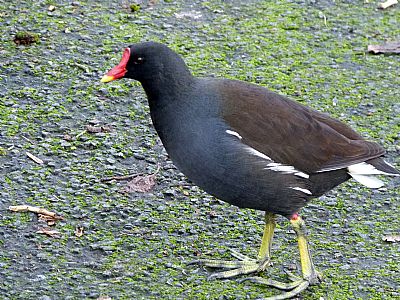
A stroll in January. These birds usualy look mainly black, but you can see a slightly blue sheen on its chest.
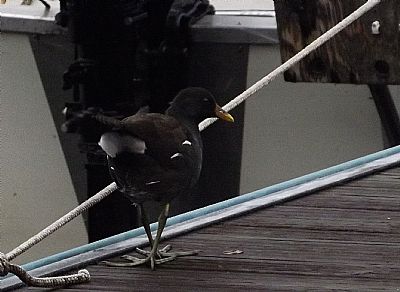
A fully grown, but immature moorhen wanders around a jetty in the upper Leven in late September.
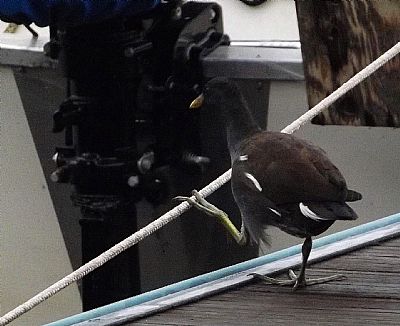
Its long toes test a rope before stepping across it and back into the water.
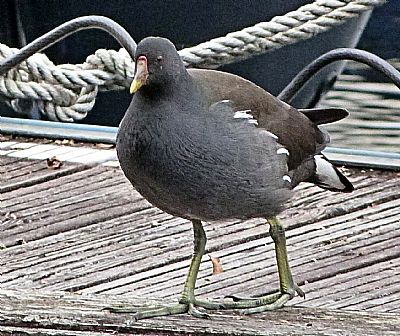
The same jetty some weeks later. Is this the same bird?
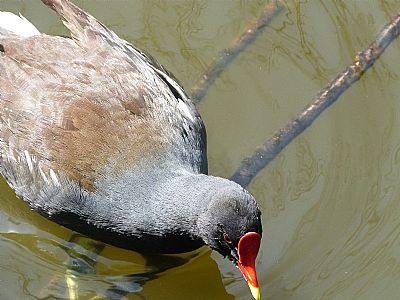
Not the easiest of perches for those long toes, but a young moorhen teeters on some sticks below the water surface for an instance before reaching for some handouts.
You can see how the chick is born black and then transitions to an elegant grey/brown before becoming a smart black with some white and a red beak tipped with yellow. This seems to have confused identification sometimes. See the notes about the "common gallinule" below.
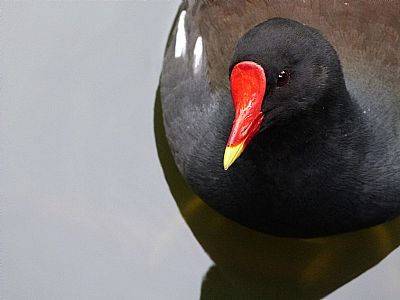
What a fine looking bird I am!
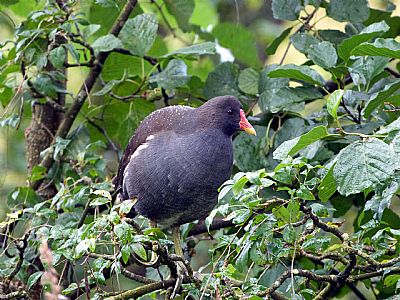
So yfou thought moorhens were just water and ground birds. This one found a comfortable perch well up a tree. September. (Alexander Park).
COMMON GALLINULE
Our moorhen is apparently the same as that found in the USA. However there is some opinion there that there are two distinct species of gallinule there - the moorhen (Gallinula chloropus) and the common gallinule (Gallinula galeata). The differences are really obscure, subtle. This opinion that there are two distinct species is not universally shared.
If you peruse the photos above, you may also notice a variation in colouration, greys and browns. This variation occurs through their life stages and there may even be contrasts amongst adult or nearly adult birds. We consider that in the UK there is only one species which can go under either name.
For the record though Wiki tells us that was split from the common moorhen by the American Orthonlogist Union in July 2011. This appears to be solely a USA interpretation. UK sources including that of the RSPB make no mention of this differentation. However some websites do offer means of differentation. See Flutter Verses website as per the link below - another US source. For our purposes there is only one moorhen and it differs in appearance through its growth cycles.
FLUTTER VERSES website : https://theflutterverses.com/common-moorhen-vs-common-gallinule/
RSPB : https://www.rspb.org.uk/birds-and-wildlife/wildlife-guides/bird-a-z/coot/
https://www.rspb.org.uk/birds-and-wildlife/wildlife-guides/bird-a-z/moorhen/
WIKIPEDIA : https://en.wikipedia.org/wiki/Common_gallinule

